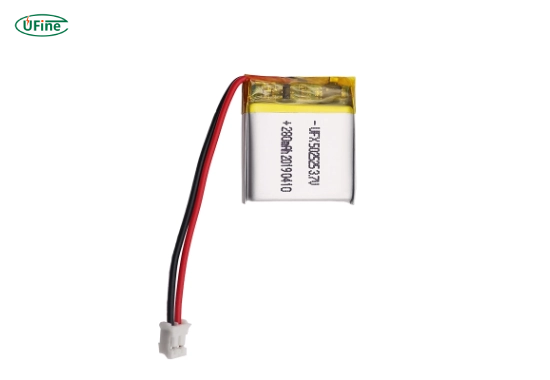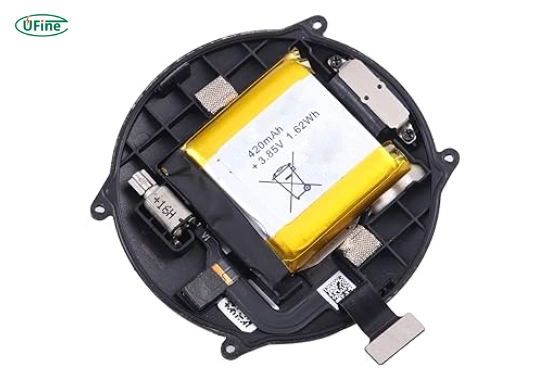
- Part 1. What is a lithium watch battery and why is it important?
- Part 2. Benefits of using a lithium battery in watches
- Part 3. Understanding lithium watch battery sizes and codes
- Part 4. Which watches use lithium batteries and soft-pack lithium cells?
- Part 5. How to choose the best lithium watch battery for long life and performance?
- Part 6. How to safely replace a lithium watch battery?
- Part 7. How long do lithium watch batteries last in smartwatches and analog watches?
- Part 8. Are custom lithium watch batteries available for unique watch designs?
- Part 9. Safety tips when handling lithium watch batteries
- Part 10. Where to buy lithium watch batteries and how to ensure quality?
- Part 11. FAQs about lithium watch battery
How to choose the best lithium watch battery for your timepiece? This is a question many watch owners ask when their watch starts running slow or suddenly stops working. Choosing the right battery can significantly affect the performance, lifespan, and safety of your watch.
Whether you own a traditional analog watch, a digital sports watch, or a high-end smartwatch like the Apple Watch, selecting the correct lithium battery is critical. In this in-depth guide, we will explore everything you need to know about lithium watch batteries, including types, specifications, compatible models, and even custom battery options for specialized needs.
Part 1. What is a lithium watch battery and why is it important?
A lithium watch battery is a compact, high-energy power source used in both traditional and modern watches. These batteries are usually coin-shaped and are known for their high voltage (3V), long shelf life, and excellent temperature resistance.
Unlike alkaline or silver oxide batteries, lithium batteries deliver consistent energy output and are ideal for watches that require stable voltage for accurate timekeeping. They are most commonly found in digital watches, analog-digital hybrids, fitness trackers, and smartwatches.
Understanding the role of the right lithium battery ensures your timepiece operates with maximum efficiency and reliability.
Part 2. Benefits of using a lithium battery in watches
Why should you choose a lithium battery for your watch over other types like alkaline or silver oxide?
Here are the key benefits:
- Longer battery life: Lithium batteries can last 5 to 10 years, depending on usage and watch type.
- Stable voltage output: Provides consistent energy, which is vital for accurate timekeeping.
- Lightweight and compact: Ideal for thin or luxury watches.
- Wider temperature range: Performs well in both cold and hot environments, from -20°C to +60°C.
- Low self-discharge rate: Holds charge longer when not in use.
These advantages make lithium watch batteries especially useful in smartwatches and fitness bands, which require steady power over longer periods.
Part 3. Understanding lithium watch battery sizes and codes
To choose the right lithium watch battery, you need to understand how battery model numbers work. Most lithium button cells follow a standard format, such as CR2032.
Here is how you decode it:
- C: Lithium manganese dioxide chemistry
- R: Round shape
- 20: Diameter in millimeters (20 mm)
- 32: Thickness in tenths of millimeters (3.2 mm)
Common lithium battery sizes for watches include:
- CR2032: Popular in digital watches and fitness trackers
- CR2025: Slightly thinner version, used in compact watches
- CR2016: Used in slim analog-digital watches
- CR2450: Higher capacity, common in smartwatches and medical devices
Always check your watch manual or existing battery before purchasing a new one. Using the wrong size can lead to poor performance or even damage your watch.
Part 4. Which watches use lithium batteries and soft-pack lithium cells?
Most modern watches now use lithium coin cells or soft-pack lithium batteries for better performance and compact design.
Some examples include:
- Smartwatches (such as Apple Watch, Samsung Galaxy Watch, Huawei Watch): These devices use custom soft-pack lithium polymer batteries due to their slim size and high energy density.
- Fitness bands (like Fitbit or Garmin): Require rechargeable lithium batteries for daily use and long runtimes.
- Hybrid watches: Combine analog and digital features and often rely on lithium coin cells like CR2032 or CR2025.
- High-end analog watches: Still use non-rechargeable lithium coin cells due to their long lifespan and compact size.
For manufacturers or brands developing new watch models, we also offer custom lithium battery solutions, including soft-pack lithium batteries tailored for unique design and power requirements. These are ideal for wearable devices that need compact, safe, and reliable energy sources.
Part 5. How to choose the best lithium watch battery for long life and performance?
When choosing the best lithium battery for your watch, consider the following factors:
- Battery size and compatibility
Using the wrong size can cause poor contact or even short circuits. Always check your existing battery’s code and match it. - Voltage and capacity
Most lithium coin cells deliver 3 volts, but their mAh capacity can vary. For instance:- CR2016: 90 mAh
- CR2025: 150 mAh
- CR2032: 220 mAh
- CR2450: 600 mAh
- Brand and quality
Stick to reliable brands for consistent performance. Look for batteries from:- Panasonic
- Energizer
- Sony/Murata
- Maxell
- Renata
Part 6. How to safely replace a lithium watch battery?
Replacing a lithium battery is simple but requires precision. Here’s how to do it safely:
- Gather your tools: You’ll need a small screwdriver, tweezers, and possibly a watch case opener.
- Open the watch case: Carefully remove the back panel without scratching the case.
- Remove the old battery: Use tweezers to gently lift the battery out.
- Insert the new battery: Make sure the positive (+) side is facing up.
- Re-seal the case: Ensure the case is properly closed to retain water resistance.
If you’re unsure or if your watch is expensive, it’s best to take it to a professional repair shop.
Part 7. How long do lithium watch batteries last in smartwatches and analog watches?
The lifespan of a lithium watch battery depends on the type of watch:
- Analog watches: With minimal features, a lithium coin cell can last 5 to 10 years.
- Digital watches: With alarms and lights, expect 3 to 5 years.
- Smartwatches: Rechargeable lithium-polymer batteries need charging daily or weekly, but the battery unit itself can last 2 to 3 years before replacement.
Custom lithium batteries for smartwatches are designed to offer high cycle life and safety, and we specialize in manufacturing soft-pack lithium batteries that meet international safety standards for wearables.
Part 8. Are custom lithium watch batteries available for unique watch designs?
Yes, if you’re a watch manufacturer or product designer working on a unique timepiece, you may need a custom lithium battery to fit your watch’s shape, size, and power needs.
We offer:
- Soft-pack lithium batteries for slim or curved watch designs
- Custom voltage and capacity configurations
- High-safety lithium polymer cells for wearable applications
- OEM and ODM development support
Whether you’re designing a next-gen smartwatch or a hybrid analog-digital model, we can help you develop the perfect lithium battery solution.
Part 9. Safety tips when handling lithium watch batteries
Lithium batteries are generally safe, but here are some tips to avoid problems:
- Store batteries in a cool, dry place
- Keep away from children and pets
- Do not puncture, crush, or expose to fire
- Recycle used batteries at certified centers
- Avoid mixing old and new batteries
If a battery leaks or swells, stop using it immediately and dispose of it safely.
Part 10. Where to buy lithium watch batteries and how to ensure quality?
You can buy lithium watch batteries from:
- Authorized electronics retailers
- Online stores like Amazon
- Watch repair shops
- Direct from battery manufacturers
Make sure to:
- Check the expiration date
- Avoid unbranded or generic batteries
- Look for authentic packaging
- Buy from trusted sources
As a professional lithium battery manufacturer, we offer bulk supply and custom services for watchmakers, OEM brands, and electronics developers.
Part 11. FAQs about lithium watch battery
What is the best lithium battery for Apple Watch replacement?
The Apple Watch uses a custom soft-pack lithium-polymer battery, not a coin cell. For replacement, it is critical to use a high-quality lithium battery with the correct voltage and dimensions. We offer custom lithium batteries designed for smartwatches like Apple Watch, ensuring safety, durability, and long life.
Which lithium battery lasts the longest in analog watches?
For analog watches, the CR2032 lithium coin cell is among the most popular and long-lasting, often providing 6 to 10 years of service. If your watch supports it, choosing a high-capacity CR2450 can offer even better performance.
Can I use a rechargeable lithium battery in a non-rechargeable watch?
No. Non-rechargeable watches are not designed to handle charging voltage. Using a rechargeable lithium battery can damage the watch circuit or cause battery failure. Always match the battery type to your watch’s requirements.
What is the safest way to replace a lithium battery in a smartwatch?
Smartwatches often use custom soft-pack lithium batteries, which require special tools and skills to replace. The safest method is to take it to an authorized technician. We manufacture custom lithium batteries for smartwatches, designed with built-in protection circuits to ensure safe operation.
Where can I get custom lithium batteries for watch manufacturing?
If you’re a watch manufacturer or designer, you can contact us for custom lithium battery solutions, including soft-pack lithium-polymer batteries for smartwatches, hybrid watches, and fitness bands. Our team provides OEM support, technical design, and high-volume production tailored to your needs.
Related Tags:
More Articles

Battery Rust vs Corrosion: Key Differences and How to Deal With Each
Learn the key differences between battery rust and corrosion, their causes, and how to fix each. Discover why lithium batteries are built to resist both issues.
Why Lithium Batteries Don’t Rust: Chemical Stability Explained
Learn why lithium batteries don’t rust. Their iron-free chemistry and moisture protection make them more corrosion-resistant than lead-acid or alkaline types.
Server Rack Battery vs UPS Battery: What’s the Difference
Discover the difference between server rack and UPS batteries. Compare design, chemistry, performance, and maintenance to select the best data center backup.
How to Choose the Right Server Rack Battery for Your Data Center?
Find out how to choose the right server rack battery for your data center. Consider capacity, runtime, safety, and compatibility for reliable backup power.
What Is a Server Rack Battery? A Complete Guide for Data Centers and IT
Discover what a server rack battery is, how it works, and why it’s essential for reliable data center and IT power backup. Learn key features and benefits.




